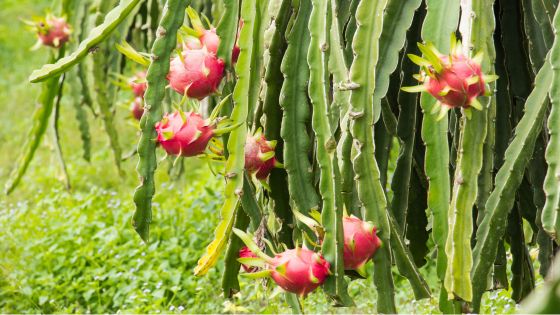Does Dragon Fruit Need a Lot of Water? Watering Guide

Do you want to know if Dragon fruit needs a lot of water? Dragon fruit, also known as pitaya, is a tropical fruit gaining popularity for its unique look and delicious taste.
But how much water does this exotic plant need? In this article, we will delve into the watering needs of the dragon fruit plant and provide you with a comprehensive guide on keeping your plant healthy and thriving.
Does Dragon Fruit Need a Lot of Water?
This plant doesn't need frequent watering. Dragon fruit plants need deep weekly watering for proper growth. Increase watering frequency during hot, dry periods to avoid wilting. Water deeply, targeting roots and avoiding leaves.
Mulch retains moisture. Signs of underwatering include wilting and poor fruit development.
Attention to avoiding parched desiccation
This remarkable cactus requires careful attention to avoid parched desiccation and sodden decay.
- Firstly, rich, loamy soil with substantial organic matter helps retain moisture while permitting drainage. Amending the planting bed with compost or well-rotted manure creates an ideal medium.
- Secondly, thorough irrigation allows water to permeate deeply to nourish the extensive root system. However, don't oversaturate, as excess moisture prompts fungal and bacterial rots. I recommend drip irrigation on a timer, supplying water early in the day.
- Furthermore, drought-stressed plants abort flowering and fruit sets. Leaves lose turgor and begin wilting. Stems shrivel, and segments collapse. Supplying water revives the plant, but prolonged moisture deficit permanently damages the cambium.
- Additionally, fruit swelling depends on adequate water. Insufficient hydration causes misshapen, undersized yields. Yet overwatering provokes cracking, splitting, and increased susceptibility to phytophthora fungus.
In summary, dragon fruit requires a balance of soil moisture to thrive. Neither desiccate nor saturate. Timed drip irrigation into a well-prepared bed provides an optimal regimen.
Careful observation of the plant's needs allows for customizing the watering schedule. With proper hydration, abundant flowers and flavorful fruits reward the diligent gardener.
Ready to embark on a journey into the world of exotic fruits? Dive into our latest article, ‘Unveiling the Mystery: Where Does the Dragon Fruit Grow?‘ and discover the fascinating origins of this vibrant, delicious fruit. Don’t miss out, start exploring now!
Understanding Dragon Fruit
Dragon fruit is a type of cactus that thrives in warm climates. It's a climbing plant that often grows on tree trunks, abandoned walls, or boulders.
The fruit it produces is known for its bright red skin and white pulp, which is both delicious and nutritious.
Despite its tropical origins, dragon fruit is a surprisingly drought-tolerant plant. This means it doesn't require frequent watering, making it an excellent choice for those who don't have much time to dedicate to plant care.
However, while dragon fruit is drought-tolerant, it doesn't mean it can survive without water. Like all plants, it has specific watering needs to be met to grow and produce fruit.
Watering Needs of Dragon Fruit
Generally, dragon fruit should be watered thoroughly when the soil is arid. This is because the plant is adapted to survive where water is scarce.
Overwatering can lead to root rot and other plant diseases, harming your plant's health.
During the growing seasons of spring, summer, and fall, dragon fruit should be watered once or twice a week to keep the soil slightly wet. In winter, the watering should be reduced to prevent the soil from drying excessively.
Using rainwater or distilled water rather than tap water is also recommended, as it contains a lot of calcium, magnesium, and other mineral salts that can lead to soil compaction.
It's also essential to avoid splashing water on the stem of the dragon fruit plant when watering. The stem is susceptible to rotting if it's constantly wet.
Signs of Overwatering and Underwatering
Knowing the signs of overwatering and underwatering can help you adjust your watering schedule to meet the needs of your dragon fruit plant.
Signs of overwatering include yellowing leaves, a sudden drop of leaves, or the presence of soft, brown roots.
On the other hand, signs of underwatering include wilting or curling leaves, dry and brittle leaves, or slowing growth.
If you notice any of these signs, adjust your watering schedule accordingly. Remember, it's better to be underwater than overwater when it comes to dragon fruit.
Frequently Asked Questions
How often should I water my dragon fruit plant?
Water your dragon fruit plant once or twice a week during spring, summer, and fall growing seasons. In winter, reduce the watering to prevent the soil from drying excessively.
What are the signs of overwatering?
Signs of overwatering include yellowing leaves, a sudden drop of leaves, or the presence of soft, brown roots.
What are the signs of underwatering?
Signs of underwatering include wilting or curling leaves, dry and brittle leaves, or slowing growth.
Can I use tap water to water my dragon fruit plant?
Using rainwater or distilled water rather than tap water is recommended, as it contains a lot of calcium, magnesium, and other mineral salts that can lead to soil compaction.
Final words
Watering your dragon fruit plant doesn't have to be a complicated task. By understanding the plant's watering needs and being vigilant for signs of overwatering or underwatering, you can ensure your dragon fruit plant stays healthy and produces delicious fruit.
Remember, when it comes to watering dragon fruit, less is often more.
Jose Luis Pacheco, Wildlife Biologist and bachelor's in biology, reviewed and approved this article.
